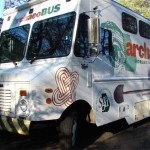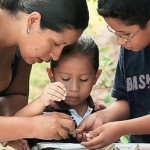You know, like a bookmobile only with archaeologists inside of librarians and artifacts instead of books!1 How completely awesome is that?
 It actually used to be a bookmobile for the Athens Regional Library System that traveled to rural parts of Northeast Georgia, but budget cuts had long since left it parked and forlorn.
It actually used to be a bookmobile for the Athens Regional Library System that traveled to rural parts of Northeast Georgia, but budget cuts had long since left it parked and forlorn.
As a member of the Society for Georgia Archaeology, archaeologist Thomas Gresham had long wanted to put together a roving archeology show.
When he joined the library board and the subject of what to do with ye olde bookmobile came up, he proposed they sell it to the SGA for a mobile museum. Nine hundred bucks changed hands and the deal was done.
That was two years ago, and now the ArchaeoBus is primed and ready to travel to libraries and schools in Clarke County, Georgia, showing all comers artifacts excavated locally and giving mini-instructionals and labs on archaeological processes.
So far they’ve only done one planned stop, but Rita Elliot, the archaeologist who drove it to Athens from the mechanic in Savannah where the bus was first repaired and fitted with display cases, has big plans to integrate the bus into students’ curricula.
Elliot and other volunteers want to apply about a dozen activities and presentations to students’ in-class curriculum.
Archaeologists might ask younger kids to offer theories about where an artifact like a coin or a dish came from and then explain their guesses.
Older kids might have to show how they can use the Pythagorean theorem to map out a field excavation site using string on a peg board, Elliot said.
Using the theorem, archaeologists can lay out an accurate rectangular grid system to mark the layer of the soil where artifact is found.
“You want it so that you can see the clues in the soil, and unfortunately, the only way to do that is math, so the Pythagorean theorem comes in handy time after time,” Elliot said.
How many times do teachers hear the “But how am I going to use this in the real world?” refrain. The ArchaeoBus will answer that question as well as a million others about the history of the state and the study of material remains in general.
I am so into that I could not be more into it.
